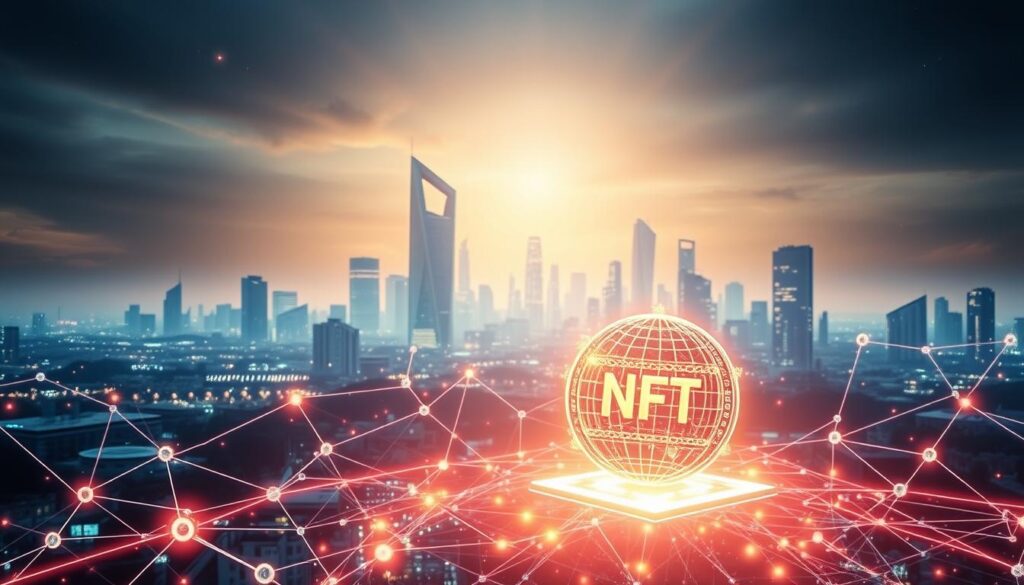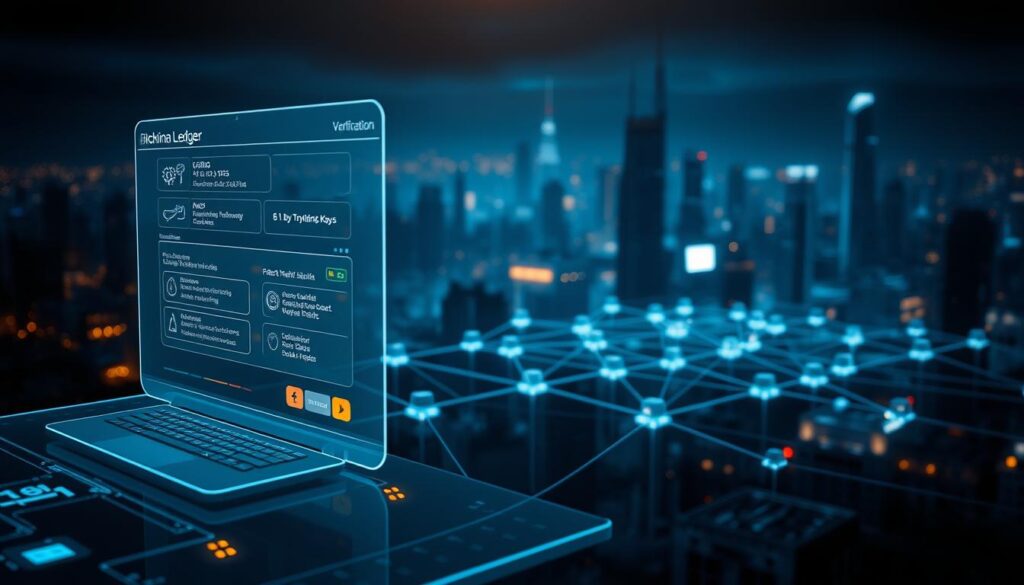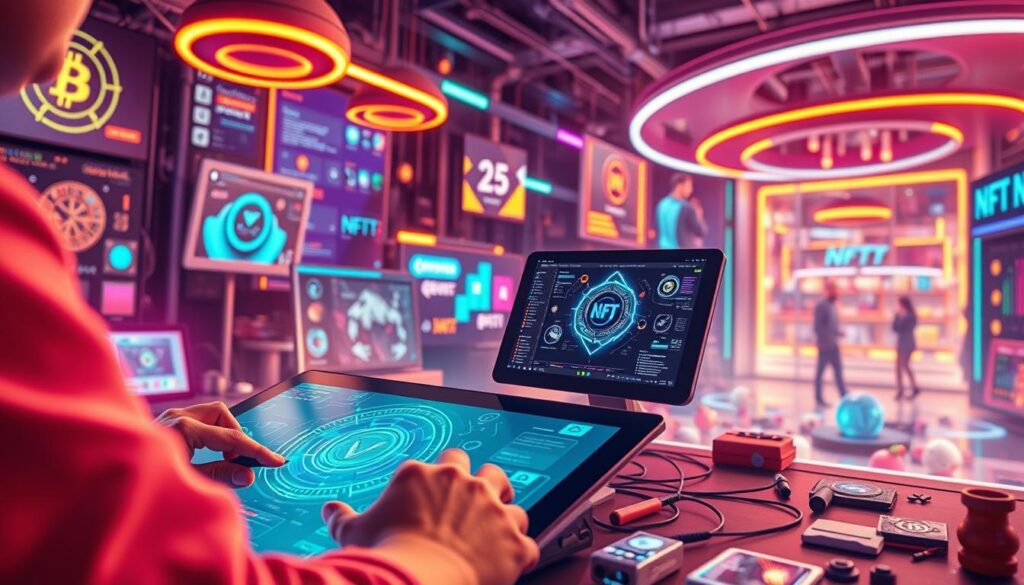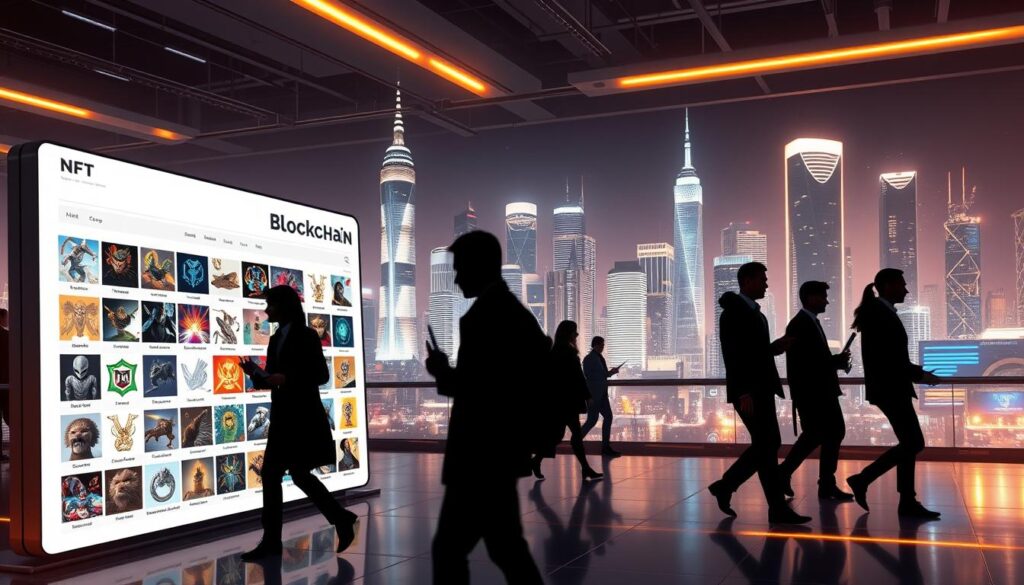Non-fungible tokens (NFTs) have reshaped how we own and trade digital items. These blockchain-based assets represent one-of-a-kind ownership of anything from artwork to music. Unlike cryptocurrencies, each token carries a unique ID, making it impossible to duplicate or replace.
The rise of NFTs has opened doors for creators worldwide. Digital artists like Beeple and musicians such as Grimes have sold pieces for millions, proving the market’s potential. Even public figures like Donald Trump have joined, showing NFTs aren’t just a niche trend.
At their core, NFTs act as digital certificates for originality. Whether it’s a video clip, virtual land, or collectible card, blockchain technology locks in authenticity. This ensures buyers receive verified ownership, while creators earn royalties from resales.
Platforms now let anyone turn their work into tradeable tokens. From animations to domain names, the possibilities keep growing. This guide will walk you through transforming your ideas into valuable assets on the blockchain.
Key Takeaways
- NFTs use blockchain to prove ownership of unique digital items like art, music, or videos.
- Each token has an unchangeable ID, preventing counterfeits and ensuring scarcity.
- High-profile sales demonstrate lucrative opportunities for both new and established creators.
- Blockchain technology guarantees transparency in transactions and ownership history.
- Royalty systems let artists earn ongoing income from secondary market sales.
Introduction to the NFT Universe
The concept of ownership is evolving faster than ever in our digital-first world. At the heart of this transformation lies a new class of assets built on groundbreaking technology.

What Are NFTs and Why They Matter
A non-fungible token acts like a digital fingerprint for any asset. Unlike money or Bitcoin, each carries distinct information that sets it apart. This uniqueness makes them ideal for representing rare items, from virtual trading cards to concert tickets.
These tokens matter because they solve a long-standing digital problem: proving scarcity. Before blockchain, anyone could copy a JPEG infinitely. Now, creators can attach provable originality to their work through NFT basics.
Digital Assets and Blockchain Fundamentals
Every NFT relies on blockchain networks – decentralized ledgers that record transactions publicly. When you mint a token, its details get locked into a chain of data blocks. This process creates an unbreakable record of ownership history.
Popular blockchains like Ethereum store not just currency transactions but entire smart contracts. These self-executing agreements enable features like automatic royalty payments. The system ensures artists benefit every time their work changes hands.
From tweets to virtual real estate, nearly anything digital can become a tokenized asset. What gives them value? A mix of cultural significance, community demand, and the ironclad security of blockchain verification.
Understanding NFT Fundamentals and the Blockchain Ecosystem
Digital ownership disputes vanish when assets live on blockchain networks. These systems store permanent records that verify who owns what – and when they acquired it. The technology’s strength lies in its resistance to alteration, making it ideal for establishing authenticity.

Immutable Ledgers and Ownership Verification
Blockchain acts as a digital notary for NFTs. Every transaction gets etched into a chain of data blocks. Once added, records can’t be edited or deleted, creating a transparent timeline of ownership.
Decentralized networks handle verification through consensus. Thousands of computers cross-check each transaction. This process eliminates reliance on banks or governments to confirm asset legitimacy.
| Feature | Blockchain System | Traditional System |
|---|---|---|
| Record Alteration | Impossible after validation | Possible with admin access |
| Verification Process | Network consensus | Central authority approval |
| Security | Cryptographic encryption | Password-protected databases |
Smart contracts add automation to ownership transfers. These code-based agreements trigger actions like royalty payments when NFTs get resold. Artists receive compensation automatically, without manual invoicing.
Beyond art, this system secures medical records and property deeds. A university could issue tamper-proof diplomas as tokens. The same principles that protect digital collectibles also safeguard sensitive documents.
how to create and sell NFTs for beginners
Turning digital creations into valuable tokens demands both creativity and technical know-how. Success in this space requires balancing artistic vision with blockchain expertise while maintaining business savvy. Let’s explore the core competencies and steps needed to transform ideas into verifiable assets.

Essential Skills for NFT Creation
Artists must develop visual narratives that capture attention in crowded marketplaces. Technical skills include understanding wallet security and platform-specific requirements. Equally vital: marketing strategies to connect with collectors and build lasting value.
| Skill Type | Key Components | Impact |
|---|---|---|
| Artistic | Digital design, storytelling, originality | Drives collector interest |
| Technical | Blockchain basics, minting tools, gas fees | Ensures proper tokenization |
| Business | Pricing models, community engagement | Sustains long-term success |
Overview of the NFT Minting Process
Minting converts digital files into blockchain-registered assets. Creators upload artwork, add descriptive metadata, and select royalty percentages. Network fees vary based on blockchain traffic and file complexity.
Smart contracts automate ownership transfers and royalty distributions. This process establishes scarcity while allowing updates for limited editions. Choosing the right platform aligns your work with suitable collectors and trends.
Choosing the Right Blockchain and NFT Marketplace
Your blockchain choice determines your project’s reach, costs, and technical capabilities. This decision affects everything from transaction fees to environmental impact, making research essential before minting.

Assessing Blockchain Options and Consensus Mechanisms
Ethereum dominates the space but faces congestion issues. Networks like Polygon and Solana offer faster transactions at lower costs. Consider these factors:
| Blockchain | Avg. Fee | Speed | Consensus |
|---|---|---|---|
| Ethereum | $5-50 | 15 TPS | Proof of Stake |
| Polygon | $0.01-0.05 | 7,000 TPS | Plasma + PoS |
| Solana | $0.00025 | 65,000 TPS | Proof of History |
Proof of Work systems consume more energy than newer alternatives. Many creators now prioritize eco-friendly networks with carbon-neutral policies.
Evaluating Marketplace Specializations
OpenSea supports four major chains, attracting diverse collectors. Rarible works with eight networks but focuses on community-driven projects. Some platforms excel in specific niches:
- Foundation: Curated digital art on Ethereum
- Magic Eden: Solana-based gaming assets
- Zora: Music and video-focused creations
Check royalty structures before listing. Top marketplaces take 2-5% commissions, while niche platforms may charge higher fees for targeted audiences.
Setting Up a Secure Crypto Wallet
Protecting digital assets begins with choosing the right storage solution. A crypto wallet acts as your gateway to blockchain transactions, safeguarding access to tokens and collectibles. Compatibility with marketplaces and blockchain networks determines functionality and ease of use.
Selecting a Wallet Compatible with NFT Marketplaces
Browser-based options like MetaMask dominate due to their integration with Ethereum and Polygon networks. These wallets connect directly to platforms like OpenSea, streamlining minting and sales. For high-value collections, hardware devices such as Ledger Nano X offer offline key storage, blocking hackers effectively.
Marketplace requirements vary significantly. Some platforms only accept specific cryptocurrency types for fees. Always verify which blockchains and coins your chosen wallet supports. This prevents transaction failures and ensures smooth fund transfers.
Security practices make or break wallet safety. Write down recovery phrases on paper—never digitally. Multi-signature setups add approval layers for transactions, ideal for collaborative projects. Regular updates patch vulnerabilities, keeping your crypto investments secure long-term.
Balance convenience with protection. Browser wallets suit frequent traders, while cold storage protects rare assets. Test wallet-marketplace connections before listing valuable work to avoid technical surprises.
Digitizing Your Artwork and Preparing Digital Assets
The digital revolution has transformed traditional art into versatile blockchain assets. Before minting, creators must optimize their work for both visual impact and technical requirements. Proper preparation separates standout pieces from overlooked entries in competitive marketplaces.
File Formats and Quality Considerations
Choosing the right format preserves your work’s integrity across platforms. High-resolution JPEGs work for static images, while PNG files maintain transparency layers. Animated pieces demand GIF or MP4 formats, and music files require lossless WAV encoding.
| Medium | Ideal Format | Resolution |
|---|---|---|
| Digital Painting | PNG (300 DPI) | 4000x4000px |
| Animation | MP4 H.264 | 1080p+ |
| Music Track | WAV 24-bit | 44.1 kHz |
Always save original project files separately. Marketplaces compress uploads, so starting with maximum quality ensures crisp displays on collector screens.
Importance of Originality in Digital Art
Blockchain verifies ownership but doesn’t police copyright violations. Conduct reverse image searches to confirm your artwork doesn’t resemble existing pieces. Many platforms ban derivative works lacking transformative elements.
Document your creative process with timelapse video recordings or layered project files. This evidence strengthens claims of authenticity if disputes arise. For collaborative projects, secure written agreements about revenue splits and ownership rights.
Successful digital art combines technical precision with emotional resonance. Whether crafting pixel illustrations or ambient music tracks, focus on developing a signature style that collectors recognize instantly.
Minting Your NFT: Step-by-Step Process
The journey from digital file to verified blockchain asset involves critical technical choices. Platform selection and network conditions directly impact success rates and profitability.
The Technical Process of Uploading and Minting
Creators begin by connecting their crypto wallet to a chosen marketplace. Upload your artwork file, then add descriptive metadata – title, description, and properties that enhance discoverability. This data becomes permanently linked to your token’s blockchain record.
Minting converts your file into a verifiable asset through smart contract execution. Each transaction receives a unique cryptographic signature tied to your wallet address. Confirmation times vary based on network congestion and selected blockchain.
Managing Gas Fees and Transaction Costs
Gas fees – payments for blockchain computation – fluctuate dramatically. Ethereum’s peak hours often see costs exceeding $50 per minting transaction. Layer-2 solutions like Polygon reduce expenses to pennies while maintaining security.
Strategically schedule your minting during low-activity periods. Many platforms display real-time gas trackers to help avoid premium pricing. Consider batch processing multiple assets to spread fixed costs across several transactions.
Always verify final costs before confirming. Some marketplaces charge additional service fees beyond blockchain gas payments. Balancing speed and affordability ensures maximum returns from your digital creations.


No comments yet